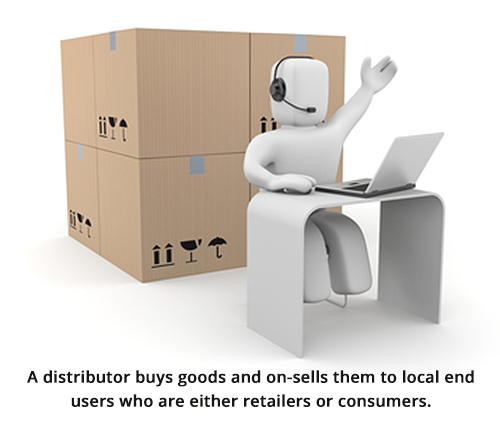When you’re manufacturing or supplying a product, it makes sense to make that product available to as many people as possible. Entering a distribution arrangement or agreement with an experienced distributor is one effective strategy to expand your market reach. But like all business relationships, distribution arrangements work best when you manage and monitor them effectively. This means putting your relationship in writing in the form of a distribution agreement.
What is a distributor?
A distributor buys or ‘takes title’ of goods, then on-sells them to local end users – either retailers or consumers. Often referred to as a reseller they may also sell to other wholesalers who in turn sell to local retailers or end users.

Unlike an agent, a distributor has no right to act on the suppliers behalf and cannot bind the supplier to their dealings with purchasers.
Distribution Arrangements or agreements in Australia
In Australia, Distribution agreements are based on contract law and are supplemented by equity and legislation. Unlike many EU countries and other civil law jurisdictions, in Australia suppliers and distributors are generally free to determine the terms of their distribution arrangements, including termination terms.
But what should you include in your Distributor Agreement? Here are just some of the things you should consider.
Parties
Who are the parties to the Agreement? Are they individuals, companies or trusts? It might seem obvious but you need to clearly identify each party to the Agreement, along with their contact details.
Product description
What are the goods that will be distributed under the Agreement? Is it a selection of the supplier’s goods or all of their products? Be specific and unambiguous.
Distribution area or territory
A well-drafted Distribution Agreement clearly specifies the area in which the distributor is to operate. The area may be for a series of postcodes, the state, or the whole country.
In addition your agreement can specify the customer category and market segment they’re permitted to operate in.
In recent times unrestricted online product sales have thrown the cat amongst the pigeons with distributors encroaching on each other’s area. With this in mind it’s worthwhile considering how your own online sales may impact the relationship with your distributors and whether or not it’s an area you want to restrict.
Exclusivity
Is your distributor arrangement to be exclusive or non-exclusive? Under an exclusive distribution agreement, the distributor is granted the exclusive right to distribute the product within a defined territory. This territory may be geographic and/or include a specific customer category and market segment.
You should also note that under Australian law, it’s illegal to enter into an exclusive dealing arrangement that has an anti-competitive effect. So you’ll need to ensure the terms of your arrangement aren’t overly restrictive.
Distributor obligations
One of the primary purposes of your Distribution Agreement is to clearly set out the distributor’s obligations.This may include an obligation to distribute the goods using their ‘best efforts’.
If you’ve entered an exclusive distribution arrangement, you may also require your distributor to meet strict quotas, adhere to reporting requirements or carry out specific marketing activities.
Whatever obligations you impose, it’s imperative they’re outlined as clearly and unambiguously as possible.
Marketing and promotion
Who will be responsible for marketing and promoting the products? Will the associated costs be shared between you? Will you use some of your profits for marketing – if so, how much? Who pays for and supplies manuals and brochures etc? How will you agree on a marketing budget? These issues should all be clearly outlined in your Agreement.
Pricing
Besides setting out where your products will be on-sold (and to whom), your Distribution Agreement should also set out how much your distributor will pay for those products. You may wish to include terms allowing the supplier to pass on increases in costs during periods of inflation or rising production costs. To reinforce the notion of an even playing field, you should allow for price increases upon a 30 day notice period.
Payment terms
As well as outlining pricing, your Agreement should also set out the payment terms. Will the supplier be paid up front for the goods or will you establish a trading account. Like your pricing, be prepared to be flexible when coming to an agreement. You may wish for shorter payment terms while your distributor would prefer longer ones – maintaining flexibility will ensure you meet somewhere in the middle.
Risk and warranties
What level of risk are you willing to assume in your distributor arrangement? As a bare minimum, you should extend a warranty to your distributor that the goods you supply are of a merchantable quality and fit for purpose. You may also wish to consider whether you’ll provide warranties for product testing before sale, or warranties that the Intellectual Property rights in the product don’t infringe any third party rights.
Disputes
What will you do if your distribution arrangement goes sour? A well-considered agreement will set out a clear dispute resolution procedure, detailing how disputes about payment or breaches of the Agreement will be dealt with.
Will mediation and arbitration be your first steps? And if so, do you share the costs? What jurisdiction can your dispute be heard in? This is particularly important if you’re entering interstate or international distribution arrangements.
Option for renewal
Do either you or your distributor want to include an option for renewal? Will renewal be automatic if certain sales targets are met? What conditions must exist for the option to kick in? If you choose to use a semi-automatic renewal, you’ll also need to include a term allowing either party to submit a notice of intention not to renew within a set period.
Terms and termination
What are the circumstances under which either party may terminate the Agreement? It’s common to include an annual termination clause allowing for termination at the end of the first calendar year after the Agreement comes into effect, and each year after that. This allows both parties to exit the Agreement without the burden of providing cause.
You should also consider what happens if the Agreement is terminated. Will you purchase the goods back from your distributor – if so, at what price and under what timeframe? How will you deal with confidential information and Intellectual Property?
What’s best for you will depend on your individual circumstances, as well as the kind of goods being distributed.
Setting the boundaries of your distribution arrangement
By including or at least considering all of the above in your Distribution Agreement, you’re setting clear boundaries. It also helps establish a level playing field, where both parties recognise what the other brings to the table thereby laying the foundation for a successful distribution arrangement.
As with any legal arrangement, you should seek legal advice if you’re unsure of your options or how best to proceed.
Distribution Agreement Resources
Distribution Agreement Template available for immediate download


